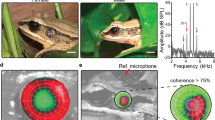Abstract
Tympanal organs of insects emit distortion-product otoacoustic emissions (DPOAEs) that are indicative of nonlinear ear mechanics. Our study sought (1) to define constraints of DPOAE generation in the ear of Locusta migratoria, and (2) to identify the sensory structures involved. We selectively destroyed the connection between the (peripheral) sensory ganglion and the tympanal attachment points of the “d-cell” dendrites; d-cells are most sensitive to sound frequencies above 12 kHz. This led to a decrease of DPOAEs that were evoked by f 2 frequencies above 15 kHz (decrease of 15–40 dB; mean 28 dB; n = 12 organs). DPOAEs elicited by lower frequencies remained unchanged. Such frequency-specific changes following the exclusion of one scolopidial sub-population suggest that these auditory scolopidia are in fact the source of DPOAEs in insects. Electrical stimulation of the auditory nerve (with short current pulses of 4–10 μA or DC-currents of 0.5 μA) reversibly reduced DPOAEs by as much as 30 dB. We assume that retrograde electrical stimulation primarily affected the neuronal part of the scolopidia. Severing the auditory nerve from the central nervous system (CNS) did not alter the DPOAE amplitudes nor the effects of electrical stimulation.








Similar content being viewed by others
References
Coro F, Kössl M (1998) Distortion-product otoacoustic emissions from the tympanic organ in two noctuoid moths. J Comp Physiol A 183:525–531
Coro F, Kössl M (2001) Components of the 2f1-f2 distortion-product otoacoustic emission in a moth. Hear Res 162:126–133
Dallos P, Fackler B (2002) Prestin, a new type of motor protein. Nat Rev Mol Cell Biol 3:104–111
Frank G, Kössl M (1996) The acoustic two-tone distortions 2f1-f2 and f2-f1 and their possible relation to changes in the operating point of the cochlear amplifier. Hear Res 98:104–115
Fuhr G, Ronacher B, Krahe R, Fest S, Shirley SG, Rogaschewski S (1999) UV-laser ablation of sensory cells in living insects. Appl Phys A 68:379–385
Göpfert MC, Robert D (2001) Active auditory mechanics in mosquitoes. Proc R Soc Lond B 268:333–339
Göpfert MC, Robert D (2003) Motion generation by Drosophila mechanosensory neurons. Proc Natl Acad Sci 100:5514–5519
Göpfert MC, Humphris ADL, Albert JT, Robert D, Hendrich O (2005) Power gain exhibited by motile mechanosensory neurons in Drosophila ears. Proc Natl Acad Sci 102:325–330
Göpfert MC, Albert JT, Nadrowski B, Kamikouchi A (2006) Specification of auditory sensitivity by Drosophila TRP channels. Nat Neurosci 9:999–1000
Gray EG (1960) The fine structure of the insect ear. Philos Trans R Soc Lond B 243:75–94
Hoy RR, Robert D (1996) Tympanal hearing in insects. Annu Rev Entomol 41:433–450
Jacobs K, Otte B, Lakes-Harlan R (1999) Tympanal receptor cells in Schistocerca gregaria: Correlation of soma positions and dendrite attachment sites, central projections and physiologies. J Exp Zool 283:270–285
Kössl M, Boyan GS (1998) Acoustic distortion products from the ear of a grasshopper. J Acoust Soc Am 104:326–335
Kössl M, Coro F (2006) L1,L2 maps of distortion-product otoacoustic emissions from a moth ear with only two auditory receptor neurons. J Acoust Soc Am 120:3822–3831
Kössl M, Vater M (2000) Consequences of outer hair cell damage for otoacoustic emissions and audio-vocal feedback in the mustached bat. J Assoc Res Otolaryngol 1:300–314
Liberman MC, Zuo J, Guinan JJ Jr (2004) Otoacoustic emissions without somatic motility: Can stereocilia mechanics drive the mammalian cochlea? J Acoust Soc Am 116:1649–1655
Lukashkin AN, Russell IJ (1999) Analysis of the f2-f1 and 2f1-f2 distortion components generated by the hair cell mechanoelectrical transducer: Dependence on the amplitudes of the primaries and feedback gain. J Acoust Soc Am 106:2661–2668
Lukashkin AN, Russell IJ (2005) Dependence of the DPOAE amplitude pattern on acoustical biasing of the cochlear partition. Hear Res 203:45–53
Manley GA, Kirk DL, Köppl C, Yates GK (2001) In vivo evidence for a cochlear amplifier in the hair-cell bundle of lizards. Proc Natl Acad Sci 98:2826–2831
Manley GA (2001) Evidence for an active process and a cochlear amplifier in nonmammals. J Neurophysiol 86:541–549
Michelsen A (1971) The physiology of the locust ear. I. Frequency sensitivity of single cells in the isolated ear. II. Frequency discrimination based upon resonances in the tympanum. III. Acoustical properties of the intact ear. Z Vergl Physiol 71:49–128
Mills DM, Rubel EW (1996) Development of the cochlear amplifier. J Acoust Soc Am 100:428–441
Mills DM (2003) Differential responses to acoustic damage and furosemide in auditory brainstem and otoacoustic emission measures. J Acoust Soc Am 113:914–924
Römer H (1976) Die Informationsverarbeitung tympanaler Rezeptorelemente von Locusta migratoria (Acrididae, Orthoptera). [Processing of information by tympanal receptors of Locusta migratoria (Acrididae, Orthoptera).] J Comp Physiol A 109:101–122
Weber T, Göpfert MC, Winter H, Zimmermann U, Kohler H, Meier A, Hendrich O, Rohbock K, Robert D, Knipper M (2003) Expression of prestin-homologous solute carrier (SLC26) in auditory organs of nonmammalian vertebrates and insects. Proc Natl Acad Sci 100:7690–7695
Windmill JFC, Göpfert MC, Robert D (2005) Tympanal travelling waves in migratory locusts. J Exp Biol 208:157–168
Yates GK, Kirk DL (1998) Cochlear electrically evoked emissions modulated by mechanical transduction channels. J Neurosci 18:1996–2003
Acknowledgments
We thank Heiner Römer for suggesting the selective mechanical ablation of d-cells in the locust ear, and we are grateful to Kerstin Röhr and Diana Baumgarten for their help with the initial ablation experiments. All experiments performed in this study comply with the “Principles of Animal Care,” Pub. No. 86-23, revised 1985, of the NIH and with the current laws of Germany. Our work was supported by grants from the Deutsche Forschungsgemeinschaft (DFG) and a stipend from the Evangelisches Studienwerk to D.M.
Author information
Authors and Affiliations
Corresponding author
Rights and permissions
About this article
Cite this article
Möckel, D., Seyfarth, EA. & Kössl, M. The generation of DPOAEs in the locust ear is contingent upon the sensory neurons. J Comp Physiol A 193, 871–879 (2007). https://doi.org/10.1007/s00359-007-0239-5
Received:
Revised:
Accepted:
Published:
Issue Date:
DOI: https://doi.org/10.1007/s00359-007-0239-5




